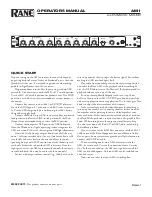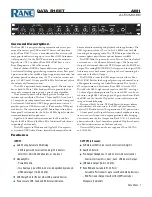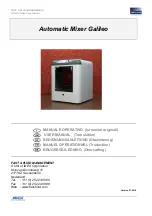
14
p 10. MONO TAP DELAY
- Typical mono delay with me set by the user TAP bu on (22) just below.
The VARIATIONS vary from 0% [1] to 75% [16] of feedback quan ty.
p 11. CHORUS
- Typical modula on e
ff
ect, provides a so , ethereal sweeping e
ff
ect. Perfect for enhancement of
electric and acous c guitar and bass. Also adds a drama c e
ff
ect to vocals, par cularly group harmonies and choirs.
The VARIATIONS increase the modula on frequency from 0.5Hz [1] to 5Hz [16].
p 12. FLANGER
- Typical modula on e
ff
ect, creates a strong sweeping e
ff
ect, par cularly e
ff
ec ve on rock electric
guitar, lead and rhythm.
The VARIATIONS increases the modula on frequency from 0.2Hz [1] to 3Hz [16].
p 13. DELAY 1
- Typical vocal hall reverb and stereo delay combined together.
The VARIATIONS vary from long tail [1] to short tail [16].
p 14. DELAY 2
- Typical vocal hall reverb and mono delay combined together.
The VARIATIONS vary from long tail [1] to short tail [16].
p 15. TAP DELAY
- Typical vocal hall reverb and mono TAP delay combined together.
The mono delay me is set by the user TAP bu on (22) just below.
The VARIATIONS vary from long tail [1] to short tail [16] and from 0% to 75% of feedback quan ty [1-16].
p 16. REV+CHORUS -
Typical vocal reverb and chorus e
ff
ect combined together.
The VARIATIONS vary from long tail [1] to short tail [16] and increases the modula on frequency from 0.5Hz to 5Hz
[1-16].
34. TAP bu on
When “TAP DELAY” e
ff
ects (p 9, 10, 15) are selected, by pushing at least two mes this bu on, it’s possible to set the
desired delay me, according to music rhythm. The TAP LED
fl
ashes in sync with the delay me set.
35. PEAK detector
The PEAK LED
fl
ashes when the e
ff
ect input signal is near to the A/D satura on point of the PROFEX processor.
IMPORTANT: if the LED PEAK
fl
ashes reduce the e
ff
ect input level turning down the AUX3 controls.
When the MUTE is engaged the PEAK LED lights ON permanently.
36. MUTE bu on
Engage this switch if you want to mute the signal from the internal e
ff
ect, when the MUTE is engaged the PEAK LED
lights ON permanently.
37. FX LEVEL control
It adjusts the level of the internal e
ff
ect signal sent to the MAIN MIX outputs.
38. FX TO AUX1
It adjusts the level of the internal e
ff
ect signal sent to the AUX 1 output.
39. MAIN MIX L & R xlr output (balanced)
These XLR connectors provide a balanced line-level signal that represents the fully mixed stereo signal controlled by
the MAIN MIX fader. Connect these to the inputs of your power ampli
fi
er, powered speaker or processors (equalizers,
mul -band compressors and so on).
NOTE:
the MAIN OUT is a true balanced output that can send the signal on a balanced line with or without a phantom
power ac ve. So the Mi mixer can also be used as a combina on mixer + DI box for sending the signals to a bigger
main mixer console.
40. MAIN MIX L & R jack output (balanced)
These JACK connectors are connected in parallel to the XLR connectors, so they provide the same line level signal from
the MAIN MIX stereo bus.
41. 2TRK Output
Use these unbalanced RCA connectors to send out the MAIN MIX signal to a recorder, such as an analog tape or an A/D
converter connected to a Personal Computer.
42. MAIN MIX FADER control
The MAIN MIX FADER controls the output level just before the MAIN MIX outputs and the 2TRK outputs. When the
fader is fully down the MAIN MIX is o
ff
, the "0" marking indicates a +4dBu nominal output level. Typically this fader is
set near the "0" label and le alone, but it can be used for song fadeouts or quick system-wide mutes.
43. AUX 1 jack output
This jack connector sends out unbalanced line-level signals made of the sum of the input channels' AUX 1 sends, usually
for connec ng to the inputs of an external e
ff
ect devices or stage monitor ampli
fi
ers.
44. AUX 2 jack output
This jack connector sends out unbalanced line-level signals made of the sum of the input channels' AUX 2 sends, usually
for connec ng to the inputs of an external e
ff
ect devices or stage monitor ampli
fi
ers.










































